Sensor Sweep: Solar Pons, Edgar Rice Burroughs, Jurassic Park, Topps Monster Stickers
Monday , 23, March 2020 Sensor Sweep 1 CommentCinema (Pulp Curry): Simba also depicts the various perspectives on the 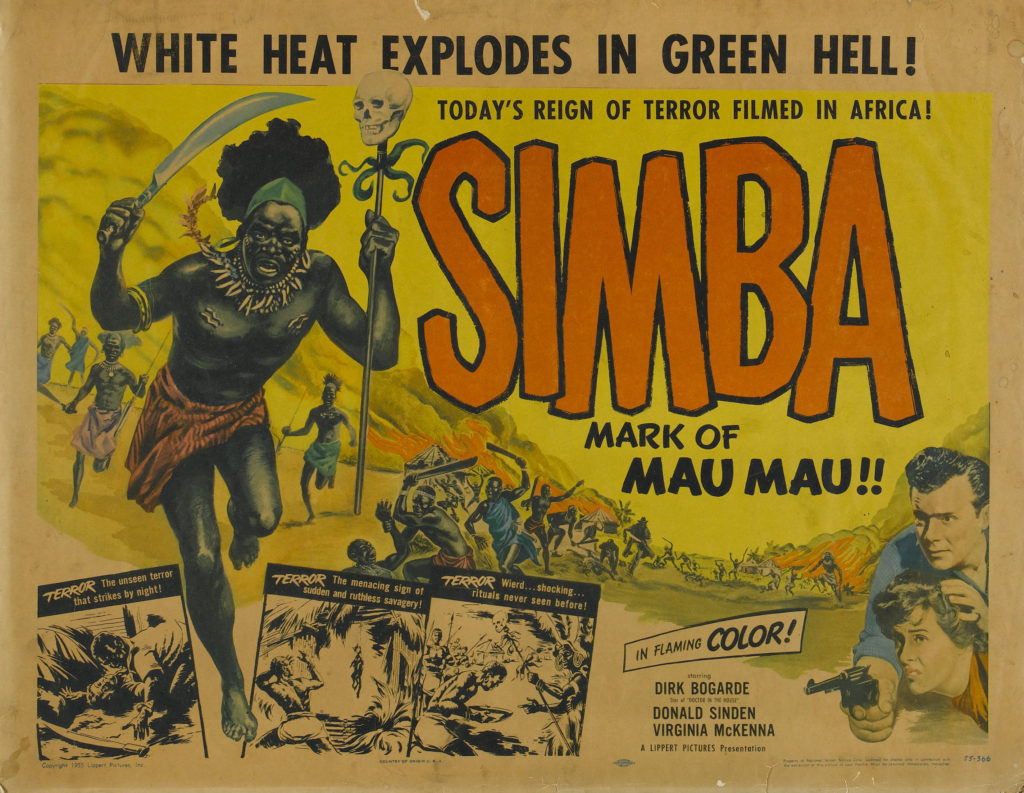 Kenyan side. In particular, is an amazing scene in which locals are inducted into the Mau Mau guerrilla movement, a ceremony that is replete with boy’s own voodoo type histrionics, but also shows that while some locals were keen to join the rebels, others simply dis so out of fear. Key to the local perspective is the character of Kenyan doctor, Peter Karanja, a white educated black man who is the subject of vicious racism by the British and mistrusted by his fellow country people. Karanja’s good intentions are also fatally undermined, unbeknownst to him, by the fact that his father is secretly the leader of the local Mau Mau.
Kenyan side. In particular, is an amazing scene in which locals are inducted into the Mau Mau guerrilla movement, a ceremony that is replete with boy’s own voodoo type histrionics, but also shows that while some locals were keen to join the rebels, others simply dis so out of fear. Key to the local perspective is the character of Kenyan doctor, Peter Karanja, a white educated black man who is the subject of vicious racism by the British and mistrusted by his fellow country people. Karanja’s good intentions are also fatally undermined, unbeknownst to him, by the fact that his father is secretly the leader of the local Mau Mau.
Science Fiction (Superversive SF): Cartwright’s Cavaliers takes place in a 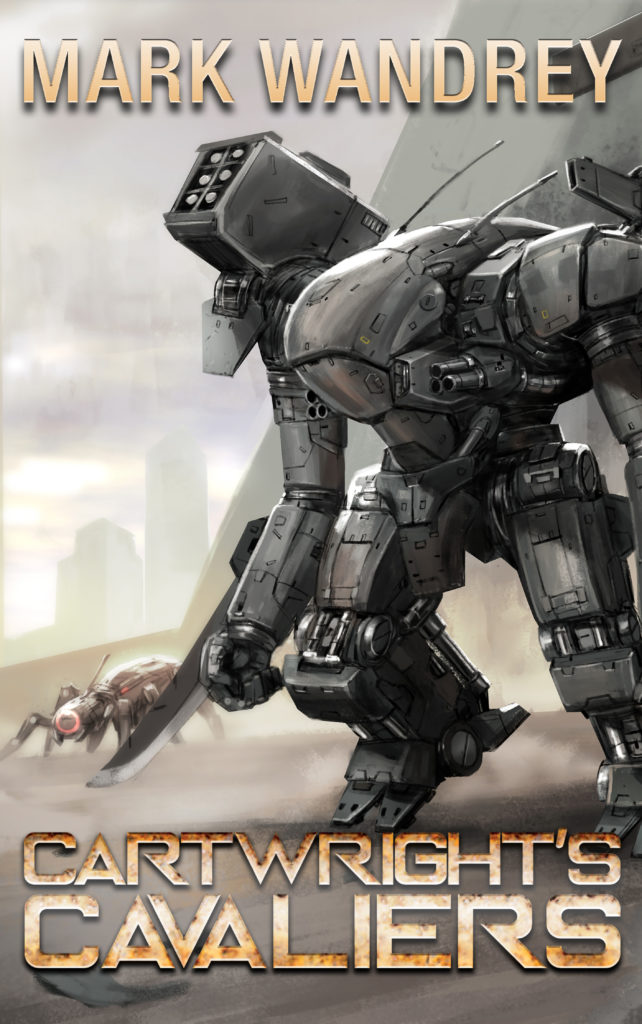 universe of relative anarchy, where a an interstellar Union rules with next to no laws. (The only one I can think of being mentioned is “Are you attacking a planet? Any ships involved in the fight can be no farther than ten miles up.”) Mercenary companies represent an enormous, galaxy wide industry, fighting for both defensive and offensive reasons, with some races more suited to the role than others. Earth, with its war-wracked past, produces some of the finest mercenary companies in the galaxy and 18-year old Jim Cartwright is the heir to one of the most famous of those groups, Cartwright’s Cavaliers.
universe of relative anarchy, where a an interstellar Union rules with next to no laws. (The only one I can think of being mentioned is “Are you attacking a planet? Any ships involved in the fight can be no farther than ten miles up.”) Mercenary companies represent an enormous, galaxy wide industry, fighting for both defensive and offensive reasons, with some races more suited to the role than others. Earth, with its war-wracked past, produces some of the finest mercenary companies in the galaxy and 18-year old Jim Cartwright is the heir to one of the most famous of those groups, Cartwright’s Cavaliers.
Pulp Fiction (Pulp Net): While many may not be familiar with the name 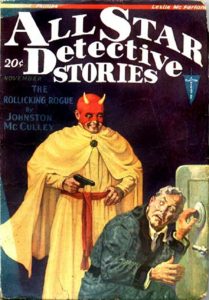 Johnson McCulley, we all probably know his most well-known character: Zorro. Zorro started off as a pulp character before moving to serials, movies, comics, and more. To keep things in context, Zorro was created in 1919, and if you read the first story, it seems clear that McCulley intended him to be a one-off character. When the 1920 movie came out, Zorro became very popular, and it wasn’t until 1922 that he followed up with the second Zorro novella, and the next didn’t appear until 1931!
Johnson McCulley, we all probably know his most well-known character: Zorro. Zorro started off as a pulp character before moving to serials, movies, comics, and more. To keep things in context, Zorro was created in 1919, and if you read the first story, it seems clear that McCulley intended him to be a one-off character. When the 1920 movie came out, Zorro became very popular, and it wasn’t until 1922 that he followed up with the second Zorro novella, and the next didn’t appear until 1931!
Fiction (Black Gate): These days, in intersection with my Conan gaming (I enjoy both Monolith’s board game and Modiphius’s roleplaying game), I 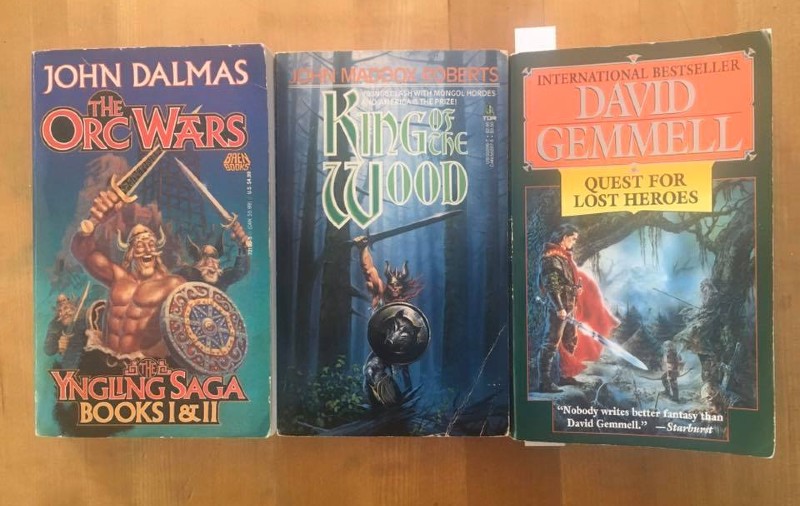 have been reading a lot of two things: weird fiction from the turn of last century into, maybe, the 1940s; and sword & sorcery — anything that, on its cover, features a muscled male wielding medieval weaponry — predominantly from the ‘70s or ‘80s. These works offer various levels of quality. Early-last-century weird fiction is in a class of its own, and, though writers of that era freely borrowed tropes, themes and elements from each other (they very much appear to have been in conversation, literally or otherwise), the form of the weird tale is not as calcified as that of sword & sorcery appears to be by the ‘80s.
have been reading a lot of two things: weird fiction from the turn of last century into, maybe, the 1940s; and sword & sorcery — anything that, on its cover, features a muscled male wielding medieval weaponry — predominantly from the ‘70s or ‘80s. These works offer various levels of quality. Early-last-century weird fiction is in a class of its own, and, though writers of that era freely borrowed tropes, themes and elements from each other (they very much appear to have been in conversation, literally or otherwise), the form of the weird tale is not as calcified as that of sword & sorcery appears to be by the ‘80s.
Fiction (Dark Worlds Quarterly): Jason M Waltz is the editor at Rogue Blades Entertainment, a company that focuses on action-driven Fantasy. His latest anthology is Death’s Sting—Where Art Thou? The book features Gothic Sword & Sorcery tales about immortals who return from Death, victorious over its sting—or horrifyingly despite! Inside this heroic anthology are stories featuring protagonists in the vein of Karl Edward Wagner’s Kane, Barry Sadler’s Casca, Steven Erikson’s Rhulad Sengar and Kallor, and Dennis O’Neil’s Rā’s al Ghūl. Dark tales of Death defeated, held at bay by willfulness, and desperately sought, its peace denied.
Tolkien (Jon Mollison): How am I just now learning about the Feanor Did 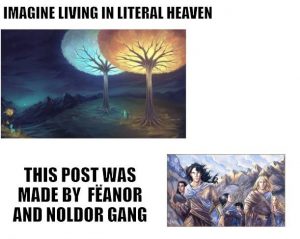 Nothing Wrong memes? For those who don’t know, the story goes a little something like this: So the Valar (kind of like the gods of Middle-Earth, but maybe like archangels or something in-between) started out by making literal heaven for the elves, and they lit it with two magic trees. An elf named Feanor caught the light and poured it and part of his essence into three amazing gems called the Silmarils.
Nothing Wrong memes? For those who don’t know, the story goes a little something like this: So the Valar (kind of like the gods of Middle-Earth, but maybe like archangels or something in-between) started out by making literal heaven for the elves, and they lit it with two magic trees. An elf named Feanor caught the light and poured it and part of his essence into three amazing gems called the Silmarils.
Edgar Rice Burroughs (DMR Books): Edgar Rice Burroughs was born the son of a no-nonsense brigadier general for the Union Army who served 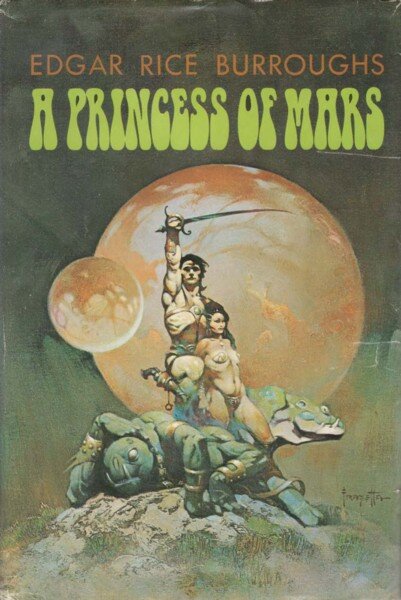 during the Civil War. Ed’s father held a dim view of his young son’s imaginative musings–deeming all of it “lying”–and punished Ed for even entertaining such frivolous thoughts. Upon reaching adulthood, Burroughs knew the pain of failure after failure. Of not meeting his father’s expectations. He had gone out to work his brother’s ranch. He had chased Geronimo with the Seventh Cavalry. He sold pencil-sharpeners. None of it with notable success. Then, he sent “Under the Moons of Mars”–henceforth to be known for all eternity as A Princess of Mars–to All-Story Magazine… and the entire world changed.
during the Civil War. Ed’s father held a dim view of his young son’s imaginative musings–deeming all of it “lying”–and punished Ed for even entertaining such frivolous thoughts. Upon reaching adulthood, Burroughs knew the pain of failure after failure. Of not meeting his father’s expectations. He had gone out to work his brother’s ranch. He had chased Geronimo with the Seventh Cavalry. He sold pencil-sharpeners. None of it with notable success. Then, he sent “Under the Moons of Mars”–henceforth to be known for all eternity as A Princess of Mars–to All-Story Magazine… and the entire world changed.
Edgar Rice Burroughs (Frontier Partisans): Burroughs lays a stronger claim to Frontier Partisan lineage than just about any other writer. The man chased The Apache Kid while serving as a cavalryman in the Arizona Territory in the 1896. That’s right — while Frederick Russell Burnham was dueling with the Matabele in Rhodesia, Burroughs was riding the rough country chasing an Apache outlaw ghost. He was the real deal.
RPG (P. C. Bushi): When I started playing Dungeons & Dragons, the full Alignment Chart was the norm. Good vs Evil, Law vs Chaos. Lawful Good was a straitlaced Bible Thumper (even though “Christian” wasn’t really a concept in the game), Chaotic Good was Robin Hood, Chaotic Evil was a serial killer, and Lawful Evil was Fascism. Law = Order, and Chaos = Randomness, in the way our group understood it.
Popular Culture (Mojo Bob): These are Topps Monster sticker designs from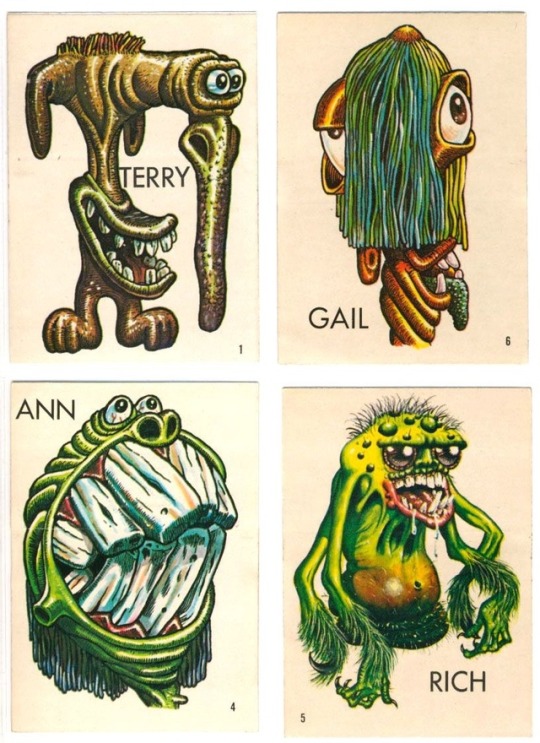 1965, the artist being (probably) Basil Wolverton. I remember these sorts of things cropping up here and there in my youth; they were all part and parcel of the style that produced the Rat Fink hot-rod cartoons and the like. Somewhere in the AD&D DMG there are some random generation tables for creating demonic critters from the infinite planes of the Abyss. These guys would suit quite well as pictorial resources for the sort of nonsense that results from those tables.
1965, the artist being (probably) Basil Wolverton. I remember these sorts of things cropping up here and there in my youth; they were all part and parcel of the style that produced the Rat Fink hot-rod cartoons and the like. Somewhere in the AD&D DMG there are some random generation tables for creating demonic critters from the infinite planes of the Abyss. These guys would suit quite well as pictorial resources for the sort of nonsense that results from those tables.
Cinema (Blog That Time Forgot): Already folk are speculating over the meaning of Jurassic World: Dominion, which has supplanted Jurassic World: New Era. It isn’t the first time in the franchise we had such a significant name change: the Malusaurus became the Diabolus, which became the MURDERSAURUS Indominus we all know and hate. But it’s one that’s worth exploring. Dominion itself is a fairly common word nowadays, but if you look, you can find all sorts of possible allusions.
H.P. Lovecraft (DMR Books): Like most stereotypes, this is generally true, 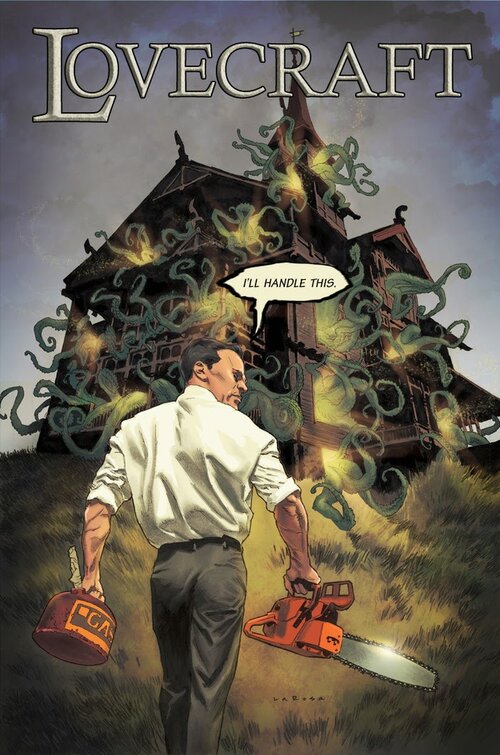 but certainly not one hundred percent accurate. REH wrote some yarns where the protagonist–after witnessing unspeakable horrors–either died, went mad or killed himself. HPL penned some tales where his protagonists actively fought back, sometimes even winning–for now. Those are the Lovecraft stories I’ll look at today. I should note that much of the violence that takes place in the stories I’m examining occurs at–or near–the end of the tales in question.
but certainly not one hundred percent accurate. REH wrote some yarns where the protagonist–after witnessing unspeakable horrors–either died, went mad or killed himself. HPL penned some tales where his protagonists actively fought back, sometimes even winning–for now. Those are the Lovecraft stories I’ll look at today. I should note that much of the violence that takes place in the stories I’m examining occurs at–or near–the end of the tales in question.
RPG (Tenkars Tavern): Dear members of the Chaosium tribe, Many of you –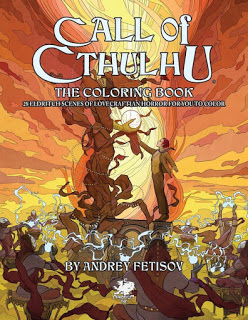 like us – may be staying put at home over the coming weeks. We’re all in this together, and to help keep spirits up and minds occupied, the Chaosium team is working on some fun and engaging diversions we can enjoy while staying in, working-from-home, in quarantine, or in self-isolation. To start things off at #homewithchaosium, we’ve made the Gold ENnie award-winning Call of Cthulhu the Coloring Book available as a free download (FREE).
like us – may be staying put at home over the coming weeks. We’re all in this together, and to help keep spirits up and minds occupied, the Chaosium team is working on some fun and engaging diversions we can enjoy while staying in, working-from-home, in quarantine, or in self-isolation. To start things off at #homewithchaosium, we’ve made the Gold ENnie award-winning Call of Cthulhu the Coloring Book available as a free download (FREE).
Detective Fiction (Pulp Net): I’ve posted several times about Solar Pons, a  popular character inspired by Sherlock Holmes that was created by August Derleth, continued by Basil Copper and more recently by David Marcum. (I think calling him a pastiche doesn’t do him justice.) We’ve gotten reprints of the original works and collections of new stories, and now we get the return of the scholarly journal on Solar Pons: The Pontine Dossier.
popular character inspired by Sherlock Holmes that was created by August Derleth, continued by Basil Copper and more recently by David Marcum. (I think calling him a pastiche doesn’t do him justice.) We’ve gotten reprints of the original works and collections of new stories, and now we get the return of the scholarly journal on Solar Pons: The Pontine Dossier.
Cool link on John McCulley. I really didn’t know much about his work other than Zorro.
I also didn’t know about the Feanor memes out there! Kudos to Jon Mollison for filling me in.